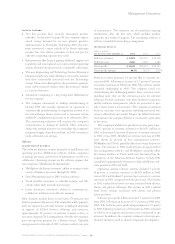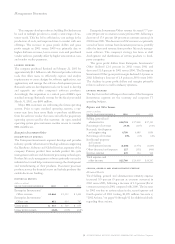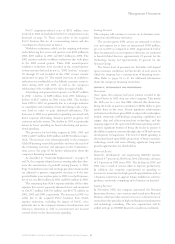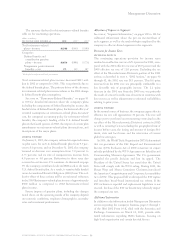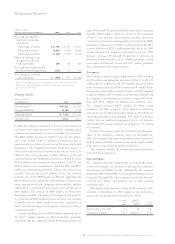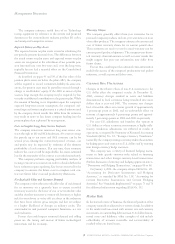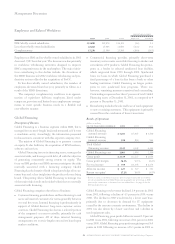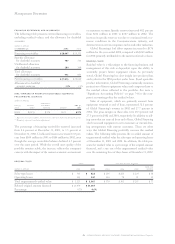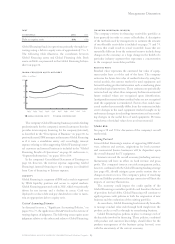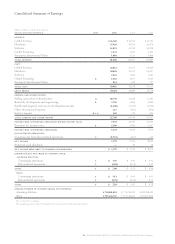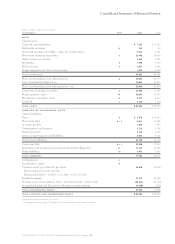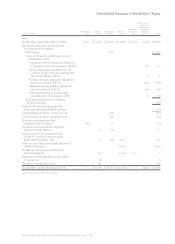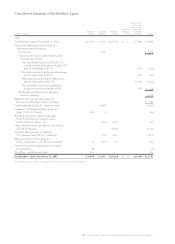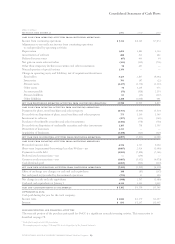IBM 2002 Annual Report Download - page 61
Download and view the complete annual report
Please find page 61 of the 2002 IBM annual report below. You can navigate through the pages in the report by either clicking on the pages listed below, or by using the keyword search tool below to find specific information within the annual report.Management Discussion
59international business machines corporation and Subsidiary Companies
The results of the sensitivity analysis at December 31,
2002, and December 31, 2001, are as follows:
Interest Rate Risk
At December 31, 2002, a 10 percent decrease in the levels of
interest rates with all other variables held constant would
result in a decrease in the fair market value of the company’s
financial instruments of $237 million as compared with a
decrease of $177 million at December 31, 2001. A 10 percent
increase in the levels of interest rates with all other variables
held constant would result in an increase in the fair value of
the company’s financial instruments of $210 million as com-
pared to $151 million at December 31, 2001. Changes in the
relative sensitivity of the fair value of the company’s financial
instrument portfolio for these theoretical changes in the level
of interest rates are primarily driven by changes in the com-
pany’s debt maturity, interest rate profile and amount. In 2002
versus 2001, the reported increase in interest rate sensitivity is
primarily due to an increase in the proportion of long-term
fixed rate debt outstanding at December 31, 2002.
Foreign Currency Exchange Rate Risk
At December 31, 2002, a 10 percent weaker U.S. dollar against
foreign currencies with all other variables held constant
would result in a decrease in the fair value of the company’s
financial instruments of $640 million as compared with a
decrease of $1,401 million at December 31, 2001. Conversely,
a 10 percent stronger U.S. dollar against foreign currencies
with all other variables held constant would result in an
increase in the fair value of the company’s financial instruments
of $660 million compared to $1,440 million at December 31,
2001. In 2002 versus 2001, the reported decrease in foreign
currency exchange rate sensitivity was primarily due to a
reduction in the amount of hedge of net investment related
currency debt outstanding after taking into account the effect
of “receive euro/pay U.S. dollar” and “receive yen/pay U.S.
dollar” cross-currency swaps executed during 2002.
Financing Risks
See page 60 for a discussion of the financing risks associated
with the company’s Global Financing business and manage-
ment’s goals to mitigate such risks while striving for superior
return on Global Financing’s equity.
The company regularly assesses these risks and has estab-
lished policies and business practices to protect against the
adverse effects of these and other potential exposures. As a
result, the company does not anticipate any material losses
from these risks.
The company’s debt in support of the Global Financing
business and the geographic breadth of the company’s opera-
tions contain an element of market risk from changes in
interest and currency rates. The company manages this risk,
in part, through the use of a variety of financial instruments
including derivatives, as explained in note l, “Derivatives and
Hedging Transactions,” on pages 84 to 86.
To meet disclosure requirements, the company performs
a sensitivity analysis to determine the effects that market risk
exposures may have on the fair values of the company’s debt
and other financial instruments.
The financial instruments that are included in the sensi-
tivity analysis comprise all of the company’s cash and cash
equivalents, marketable securities, long-term non-lease
receivables, investments, long-term and short-term debt and
all derivative financial instruments. The company’s portfolio
of derivative financial instruments generally includes interest
rate swaps, interest rate options, foreign currency swaps, for-
ward contracts and option contracts.
To perform the sensitivity analysis, the company assesses
the risk of loss in fair values from the effect of hypothetical
changes in interest rates and foreign currency exchange rates
on market-sensitive instruments. The market values for
interest and foreign currency exchange risk are computed
based on the present value of future cash flows as affected by
the changes in rates that are attributable to the market risk
being measured. The discount rates used for the present value
computations were selected based on market interest and for-
eign currency exchange rates in effect at December 31, 2002
and 2001. The differences in this comparison are the hypo-
thetical gains or losses associated with each type of risk.
Information provided by the sensitivity analysis does not
necessarily represent the actual changes in fair value that the
company would incur under normal market conditions
because, due to practical limitations, all variables other than
the specific market risk factor are held constant. In addition,
the results of the model are constrained by the fact that cer-
tain items are specifically excluded from the analysis, while
the financial instruments relating to the financing or hedging
of those items are included by definition. Excluded items
include leased assets, forecasted foreign currency cash flows,
and the company’s net investment in foreign operations. As a
consequence, reported changes in the values of some of the
financial instruments impacting the results of the sensitivity
analysis are not matched with the offsetting changes in the
values of the items that those instruments are designed to
finance or hedge.


